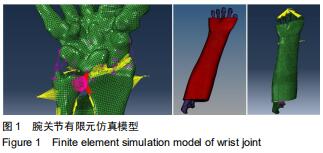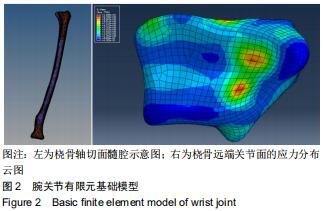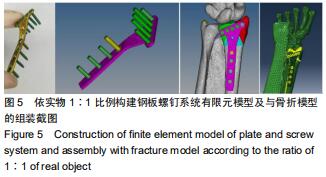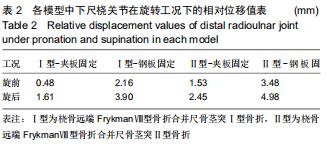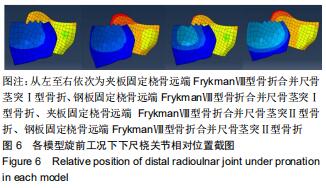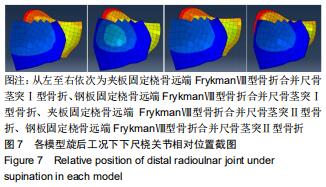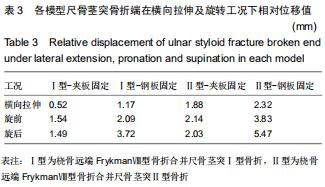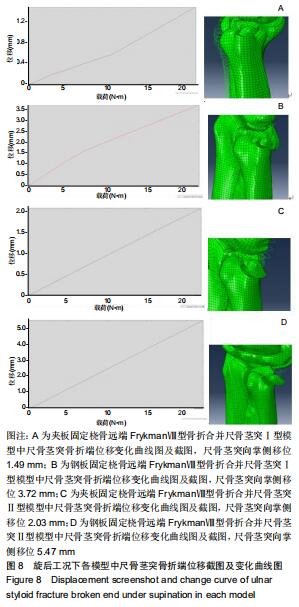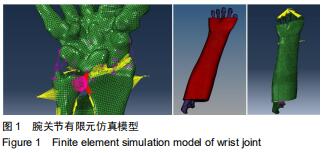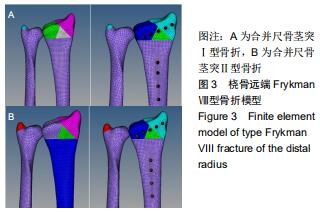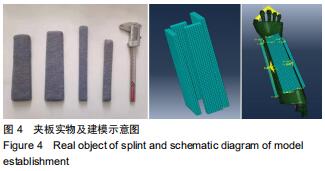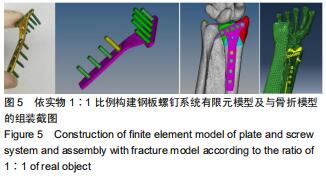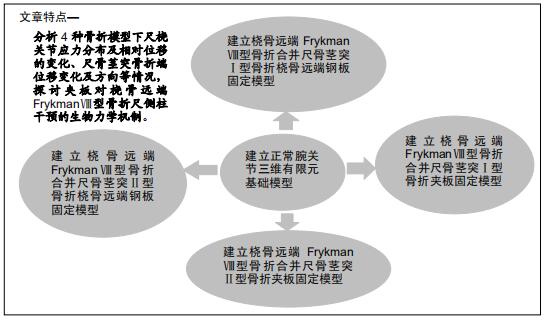中国组织工程研究 ›› 2020, Vol. 24 ›› Issue (30): 4769-4774.doi: 10.3969/j.issn.2095-4344.2831
• 骨与关节生物力学 bone and joint biomechanics • 上一篇 下一篇
夹板弹性固定桡骨远端FrykmanⅧ型骨折尺侧柱稳定性的有限元分析
李永耀1,赵 勇1,程 灏1,徐惠青1,魏 戌1,刘广伟2,成永忠1,崔 鑫1
- 1中国中医科学院望京医院,北京市 100102;2中医正骨技术北京市重点实验室,北京市 100700
Finite element analysis of intervention of splint to ulnar column in the treatment of type Frykman VIII fracture of distal radius
Li Yongyao1, Zhao Yong1, Cheng Hao1, Xu Huiqing1, Wei Xu1, Liu Guangwei2, Cheng Yongzhong1, Cui Xin1
- 1Wangjing Hospital of China Academy of Chinese Medical Sciences, Beijing 100102, China; 2Beijing Key Laboratory of Traditional Chinese Medicine, Beijing 100700, China
摘要:
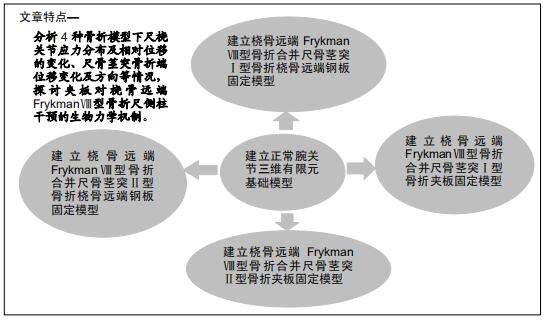
文题释义:
桡骨远端FrykmanⅧ型骨折:桡骨远端骨折Frykman分型由Frykman于1967年提出,其中桡骨远端FrykmanⅧ型骨折是指关节内骨折波及桡腕关节和下尺桡关节,同时合并尺骨远端骨折(影像学上多表现为尺骨茎突骨折),尺骨茎突发生骨折后必然合并有附着的韧带或三角纤维软骨复合体损伤,后者在维持下尺桡关节稳定性方面具有关键性作用。
有限元分析法:是借助电子计算机进行运算的数值计算方法,将待分析的连续性实体离散成为有限个单元,以各单元的结合体替代原连续体并逐个研究各单元的力学性质。它具有一些实验研究方法所不能比拟的优点,能够通过模拟分析的方法设定特殊工况,得到客观实体实验法所难以得到的研究结果,近年来其在骨科研究领域发展迅速,研究成果给临床治疗带来了积极意义。
背景:在桡骨远端骨折合并尺骨茎突骨折的临床治疗中发现,接受手法复位夹板固定治疗后出现尺侧柱并发症的比例小于接受单纯行桡骨远端切开复位内固定治疗。作者认为这与夹板在治疗周期中视腕关节为一个整体并能够提供尺侧柱的相对稳定性,能够重建腕关节三柱的稳定有关。
目的:通过有限元分析法探讨夹板对桡骨远端FrykmanⅧ型骨折尺侧柱干预的生物力学机制。
方法:基于一健康志愿者的前臂及手部CT图像建立正常腕关节三维有限元基础模型,通过有限元相关软件分网、切割造模建立桡骨远端FrykmanⅧ型骨折合并尺骨茎突Ⅰ型和Ⅱ型骨折2种有限元模型,以此为基础延伸建立出夹板及桡骨远端钢板固定的4种腕关节骨折有限元模型。分析各模型在轴向压缩、横向拉伸、旋前和旋后种工况下,下尺桡关节的应力分布及相对位移变化、尺骨茎突骨折端位移变化及方向。
结果与结论:①在横向拉伸、旋前及旋后工况下,夹板干预后桡骨远端FrykmanⅧ型骨折合并尺骨茎突Ⅰ型骨折模型的尺月韧带、尺三角韧带、掌背侧尺桡韧带应力值均小于钢板干预的相对应骨折模型;②在旋前及旋后工况下,夹板干预桡骨远端FrykmanⅧ型骨折合并尺骨茎突Ⅰ型及Ⅱ型骨折模型的下尺桡关节相对位移值均小于钢板干预的相对应骨折模型;③在横向拉伸、旋前及旋后工况下,夹板干预桡骨远端FrykmanⅧ型骨折合并尺骨茎突Ⅰ型及Ⅱ型骨折模型的尺骨茎突骨折端位移值小于钢板干预的相对应骨折模型;④结果表明,桡骨远端FrykmanⅧ型骨折后下尺桡关节的稳定性变差,其中发生尺骨茎突Ⅱ型骨折时更为明显;在此类骨折的治疗中与单纯行桡骨远端骨折内固定相比较,夹板作为弹性固定在治疗周期中视腕关节为一个整体并能够提供尺侧柱的相对稳定性,藉此进一步揭示了夹板弹性固定的优势。
ORCID: 0000-0001-7298-6727(李永耀)
中国组织工程研究杂志出版内容重点:人工关节;骨植入物;脊柱;骨折;内固定;数字化骨科;组织工程
中图分类号:
